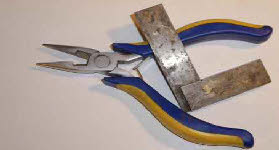


Added June 2023
Thoughts on model railway videography
I first starting making videos of Plumpton Green during lockdown, as an alternative to being able to exhibit. It took me a while to work out the best approach but here is what I learned. As with static photography, my preference is to take videos from somewhere near eye-level.
The principal tools required are:
- a camcorder, preferably 4k or better. I have a Sony FDR AX33 - quite old now, but perfectly up to the task
- a tripod
- good software to edit and compile the video clips
- studio lights are an advantage and will give an improved depth of field
For my first attempts at videoing the layout I tried to use the in-camera zoom facility. I quickly realised that this is not a good idea, for several reasons:
- trying to pan the camera to follow a moving train, and also use the zoom facility is extremely difficult to achieve
- using the zoom facility affects the perspective
The software I use is Corel VideoStudio, and this has excellent pan and zoom facilities. Starting with a 4k video it’s possible to zoom in by a factor of 2 without any visible loss of fidelity. If your initial clip doesn’t quite keep the engine (or whatever) in the middle of the frame, the pan facility can be used to adjust this.
VideoStudio allows overlays to be created and sized to display on top of the main image. I used this facility on the ‘This is Plumpton Green...’ videos to show the block bells and lever frame. Subtitles can be added as can sound (music, voiceover, engine noise etc).
I filmed each train movement as a separate clip, and stitched them altogether in the software, trimming the start and end of each clip as required, but finalising the pan and zoom for each clip after assembling all the clips in a single video. I also added in transitions between each clip (usually a 2 second cross-fade). Finalising this stage is vital - any subsequent changes to the length of a clip is likely to require a significant amount of rework, repositioning the other tracks (overlays, subtitles, sound) to match).
Once the overall shape of the video is finalised, overlays and subtitles can follow. I filmed a library of block bell and lever frame clips, and have used these repeatedly as required on all the videos I have so far made.
My first few videos are silent, but for the later ones I have added sound, and I think this is a great enhancement, although very time-consuming. I trawled the internet for videos of real steam engines, and recorded the sounds to create a library of different steam, whistles, exhaust beats etc. It is difficult to match a video of a model to the sound of a real steam engine, but well worth the effort I think.
There are links to my Plumpton Green videos here.
Thoughts on model railway videography
I first starting making videos of Plumpton Green during lockdown, as an alternative to being able to exhibit. It took me a while to work out the best approach but here is what I learned. As with static photography, my preference is to take videos from somewhere near eye-
The principal tools required are:
-
For my first attempts at videoing the layout I tried to use the in-
The software I use is Corel VideoStudio, and this has excellent pan and zoom facilities. Starting with a 4k video it’s possible to zoom in by a factor of 2 without any visible loss of fidelity. If your initial clip doesn’t quite keep the engine (or whatever) in the middle of the frame, the pan facility can be used to adjust this.
VideoStudio allows overlays to be created and sized to display on top of the main image. I used this facility on the ‘This is Plumpton Green...’ videos to show the block bells and lever frame. Subtitles can be added as can sound (music, voiceover, engine noise etc).
I filmed each train movement as a separate clip, and stitched them altogether in the software, trimming the start and end of each clip as required, but finalising the pan and zoom for each clip after assembling all the clips in a single video. I also added in transitions between each clip (usually a 2 second cross-
Once the overall shape of the video is finalised, overlays and subtitles can follow. I filmed a library of block bell and lever frame clips, and have used these repeatedly as required on all the videos I have so far made.
My first few videos are silent, but for the later ones I have added sound, and I think this is a great enhancement, although very time-
There are links to my Plumpton Green videos here.